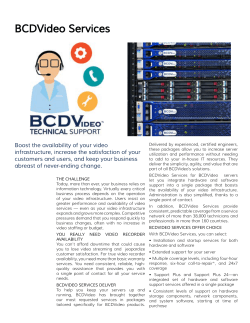
A Benchmark to Evaluate Mobile Video Upload to Cloud
A Benchmark to Evaluate Mobile Video Upload to Cloud Infrastructures authors Afsin Akdogan, HienList To,of Seon Ho Kim, Cyrus Shahabi Integrated Media Systems Center University of Southern California Introduction How to evaluate the performance of mobile video applications on these cloud infrastructures and select an appropriate set of resources for a given application? Performance Evaluation Overall Cost Analysis Other than general purpose instance, the performance difference between the optimized servers (c, r, i) is not significant even though the prices vary widely. Given: 1. A massive amount of mobile videos’ metadata. 2. Cloud providers (e.g., Amazon, Google, Microsoft) allow users to lease computing resources with varying disk, network and CPU capacities. Benchmark Design Upload videos with metadata to cloud has three stages: 1) network to transfer videos from mobile clients to the cloud servers 2) database to insert metadata about the uploaded videos 3) video transcoding to change the resolution of uploaded videos to use less storage and bandwidth Fig. 2a) Comparison of system components on smallest servers of 4 server types Fig. 2b) Number of frames that can be processed for each dollar spent (log-scale). Transcoding Analysis Multi-threading: While multi-thread technique suffers from low parallelism, parallel-single thread can utilize available CPUs better. We define a single (cross-resource) metric to evaluate the uploading workflow of video applications on cloud. Fig. 3) Scale up performance of transcoding (230MB video) Tab. 1) Categorization of the server types with the prices (dollars/hour) of the smallest and the largest servers at each group. Reducing video quality: Throughput increases significantly as the resolution decreases. However, the percentage improvement diminishes when the output video resolution becomes too small. Tab. 2) Transcoding throughput for mp4 and avi types with various output resolutions. The input video is in .m4v format with 960x540 resolution. Database Analysis Tab. 2) Hardware specifications of the smallest and largest servers of 4 types on EC2 MediaQ Architecture MediaQ: Mobile Multimedia Management System Fig. 4 ) Insertion throughput on the smallest and largest servers in 4 instance families Conclusion and Future Work Fig. 1 ) Overall architecture of MediaQ system ü This study identifies the main cost components of a multimedia system ü Transcoding is the major bottleneck, which can be more efficient by trading off the quality the video ü In the future, we aim to partition the data across multiple servers and to provide high scalability Research Sponsor Logos Here IMSC Retreat 2015
© Copyright 2025


















